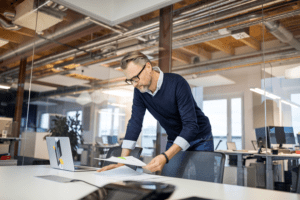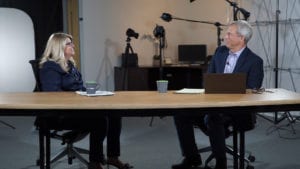We spend 90 percent of our time indoors, so ensuring safe and healthy buildings is critical. Buildings also consume a great deal of energy, so we need to make them more sustainable. I recently welcomed a panel of experts to a webinar to share their tips and success stories on how we can better seize the benefits of digitization to serve our safety, efficiency and sustainability goals. Our panel included:
Mike Hughes (MH), Schneider Electric Zone President of UK&I
Kelly Bacon (KB), Principal, America’s Workplace Lead, Strategy + AECOM
Stuart Davis (SD), London Divisional Director, Kendra Energy Solutions Ltd.
The following are a few edited excerpts from this exciting and timely discussion.

Today’s Buildings Face Many New Challenges
MK: Mike, what are some of the current challenges that put pressure on buildings? How has this been impacted by the ongoing pandemic?
MH: Whilst office occupancy in London is lower than other parts of the country due to the reluctance people to use public transport, we’re making sure buildings are safe to return to by using increased air flows, etc. With lower occupancy, it is important to be as flexible and adaptable as possible, using technology to help with automatic adjustment and remote connectivity, ensuring buildings are operating at optimum, with smarter cleaning, building services optimization, etc. Buildings are also an extension of the brand, and people want to work for companies with sustainable buildings that are doing their bit for the environment.
MK: Kelly, buildings need to be pro-active in delivering a sustainable, safe, and resilient environment. How should a building be designed and operated to create this necessary healthy environment?
KB: As occupancy increases, those buildings that have occupancy systems and utilization systems technology in place will be in a better position to manage how many people are in offices and shared areas to avoid exceeding capacity limits. The opportunity exists to connect data streams of different sensors – occupancy, circulation, ambient environmental conditions, etc. – that impact occupier well-being. Making this real time information available to occupiers and having a more interactive experience will help with confidence and navigating the building when being inside again.
MK: Stuart, what is the situation like in the UK and how are local companies adjusting to keep their occupants safe and healthy?
SD: Many companies have said that the majority of their staff will not go back to offices until 2021, and 39% are concerned about their ability to socially distance in the work space. 65% of businesses say that maintaining employee morale has been a challenge. What’s undeniable is that workplaces need to become smarter and more flexible to cater to the realities of the ‘new normal’. Space efficiencies and cost management are top concerns for many tenants, while the need to attract and retain talent by securing high quality safe and sustainable offices remains. Almost four-fifths of companies have implemented CIBSE published COVID-19 ventilation guidance, and we have been able to keep our engineers out of harm’s way by making changes remotely via the BMS. The way to rise to the challenge is through digital connectivity. Having a modern BMS is core to being able to provide remote support of buildings. And allowing users to have remote access via an app on their phone to either control their environment or give them piece of mind that their workspace is safe is becoming a must have.
We Are Seeing Many Success Stories
MK: Mike, can you share one or two examples of companies that successfully deliver on expectations and what have been your best practices for your buildings?
MH: One I will call out is Stansted Airport that we’ve been working with and who, overnight, experienced a 90% fall in occupancy. They were able to react very quickly regarding what they needed to do with the building, what areas were being occupied, and to put in a whole new set of procedures that allowed them to reduce operating costs. We’re seeing a trend where people are now aware they need more data to make decisions. If you want to have safety and operate effectively, it all starts with having a connected, smart, and sustainable building. Schneider Electric likes to ‘walk the talk’, and now operates 13 Net-Zero buildings around the world, including a 5-story building that is totally energy-autonomous, and the first to exceeding 100 points in LEED certification.
MK: Kelly, there is [often] a disconnect between building systems’ data and what that means for the buildings’ occupants. How do you see this evolving?
KB: The majority of our building stock is reactive, and there is the potential for all of them to be not only proactive and responsive, but also intuitive. Occupiers are now more than ever given choices as to where they work, so it is realistic to assume they will be choosing the buildings that have the healthiest environmental elements. During a pilot we conducted, at the end of a three-hour work session we were all losing our train of thought, so we checked the comfort score of the room. Sure enough, the room was ‘in the red’ in temperature and CO2 levels, which is why our cognitive functioning was impaired. If occupants are given the ability to check the comfort score of the room, they can decide to go outside for a bit, or change rooms, etc. These things are all actionable, with relatively simple solutions.
MK: Stuart, buildings also need to be safe and healthy for the environment. For example, one challenge is achieving carbon net-zero. How do you deliver on these expectations?
SD: Energy efficiency is a key part of a sustainable low cost net-zero journey. There’s a trade-off between energy costs and higher quality air. However, using the right sensors and reporting tools presents a significant opportunity to use data to demonstrate an optimal indoor air environment while improving energy efficiency. UCL is London’s leading multidisciplinary university and has more than 230 buildings across its campus. During lockdown we safely maintained the campus using remote BMS connectivity. As the situation is constantly evolving, UCL needs to ensure their buildings are dynamic to meet the needs of students and academics. UCL has committed to net zero carbon buildings by 2024, which includes the reduction of energy consumption by 40%. This was a challenging commitment in the outset but is now much more challenging in the ‘new normal’. It will require deployment of more intelligent IoT devices to gather greater data to help us optimize the efficiency of healthy buildings.
This innovation talk has highlighted how buildings need to transition to an all-digital platform that can help meet new demands. Leveraging our experience, sharing best practices, and being open to changing our buildings infrastructure will help drive a more sustainable, resilient, hyper-efficient, and people-centric future. Visit LinkedIn to watch the complete Innovation Talk, which also covers the importance of having an ecosystem of partners to help solve business challenges. To learn more about this topic, visit our EcoStruxure for Building’s solution page.



